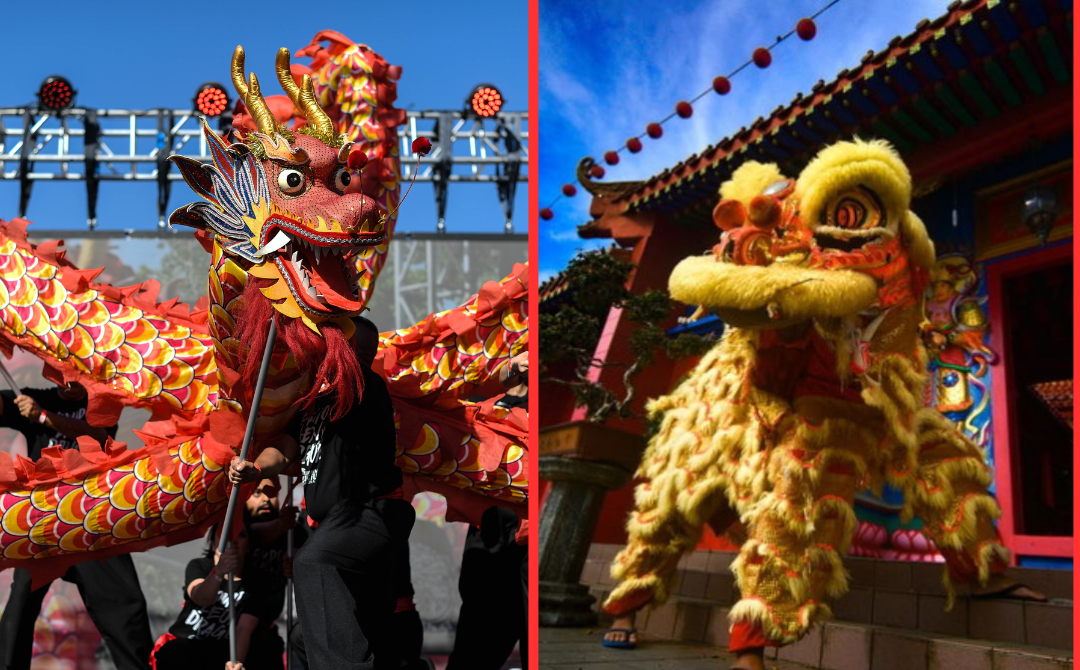Traditional performances explored: Differences between lion and dragon dance?
While the lion dance is widely recognised as a symbol of the celebrations, the coexistence of the dragon dance during festive occasions often leads to confusion.
SHARIFAH SHAHIRAH
SHAH ALAM - As we step into the Lunar New Year, various celebrations will be presented, and celebrated by diverse communities.
The celebration in Malaysia is typically marked by vibrancy, accompanied by food, dances, and the sound of fireworks embellishing the night of the celebration.
While the lion dance is widely recognised as a symbol of the celebrations, the coexistence of the dragon dance during festive occasions often leads to confusion.
To unravel the distinctions and uncover the symbolic representations of each, let's delve into these traditional performances in the upcoming discussion.
Lion dance
In traditional Chinese belief, the lion dance holds symbolic significance, representing power, wisdom, superiority, courage, and stability. It is believed to ward off evil spirits. Originating in China 5,000 years ago, the lion dance is a revered traditional art form in Chinese and other Asian cultures.
Performers, adorned in a lion costume, mimic the movements of a lion to usher in good luck and fortune. This dance serves as a means to chase away ghosts and evil spirits, particularly during Chinese New Year and various traditional, cultural, and religious festivals.
It is also a staple at significant events like business openings, celebrations, and wedding ceremonies. The lion dance comes in two styles: southern and northern, with each lion controlled by two performers, one managing the head movements and the other following the footwork in the tail.
Chinese lion dances involve two "dancers" in a lion costume, with the one in front as the head and front limbs, and the one behind as the back and hind legs. Performers wear costumes matching the lion's body colour, and sometimes the attire extends to shoes resembling the lion's paws.
There are various styles of lions, with the Northern and Southern being the most prominent. The Northern lion, historically entertaining the Imperial Court, resembles a fu lion with a flowing mane. The Southern lion, more symbolic, is divided into subgroups like Hok Shan and Fat Shan, each with distinctive features. The drum guides the lions, with cymbals and gong adding rhythm to the performance.
Dragon dance
The dragon dance is a traditional Chinese performance commonly performed during festive occasions like Chinese New Year. This captivating dance involves a team of performers manipulating a long and flexible giant dragon puppet. The dance accompanied by the rhythmic sounds of cymbals, gongs, and a big drum, and has been part of Chinese tradition for over two thousand years, dating back to the Han Dynasty.
The dance is closely tied with Chinese tradition of worshipping dragons, the dragon is considered an auspicious creature symbolising power, dignity, fertility, wisdom, and believed to bring good luck, as the dance is associated with positive qualities.
The dragon moves involve a team of performers using poles to move a dragon prop rhythmically or known as longwu or longdeng, with the belief that the longer the dragon is in the dance, the more luck it is to bring to the community.
According to The National Library Board (NLB), the history of the dragon dance dates back more than two thousand years, as mentioned in the Hanshu, a historical book about the Han Dynasty. Dragon dances can vary in style and colour, each carrying distinct meanings.
Green symbolises a great harvest, yellow signifies respect for the empire, gold or silver represents prosperity, and red is used to create excitement and usher in good fortune.
The dragon dance costume typically includes a large dragon's head and a long, segmented tail lifted on poles. The length of the dragon can range from two metres to impressive lengths exceeding 1,000 metres.
Odd numbers of dragon joints are considered auspicious, leading to the creation of dragons with varying joint counts, such as 9-jointed, 11-jointed, 13-jointed, or even 29-jointed dragons.
The differences between the Lion and Dragon dance
The lion dance and dragon dance are both traditional Chinese performances that date back thousands of years and are often seen during Chinese New Year celebrations. The most significant differences between the two dances are as follows:
Number of Performers
The lion dance involves a duo, with one performer controlling the head and the other managing the tail. In contrast, the dragon dance necessitates a minimum of nine performers to handle the dragon puppet, which can extend up to 90 meters.
Visibility of Dancers
Within the lion dance, both performers remain concealed within the lion costume. Conversely, in the dragon dance, performers are entirely exposed as they manipulate the dragon puppet.
Accompaniment and Interactions
The lion dance is often accompanied by gongs and cymbals and followed by a person dressed as a ‘Laughing Monk,’ and it is common for people to place red cash-filled envelopes in the lion's mouth. On the other hand, the dragon dancers do not receive money and perform by chasing a ball on a stick held by a performer.
Symbolism and Style
The lion's motions are often brisk and energetic, involving impressive acrobatics and martial arts, while the dragon focuses on flow, requiring more footwork and group coordination.
While both dances are intended to bring luck and prosperity, they differ in terms of the number of performers, visibility of the dancers, accompaniment, interactions, and symbolism and style.
Although both dances share the common purpose of ushering in luck and prosperity, they exhibit distinctions in terms of the number of performers, visibility of dancers, accompaniment, interactions, symbolism, and style.














